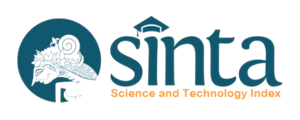EFFECTS OF PEER TEACHING ON GRAMMAR LEARNING: DOES IT ENHANCE LEARNER AUTONOMY?
(1) Universitas Kristen Satya Wacana
(2) Scopus ID: 38161752200, Universitas Kristen Satya Wacana, Salatiga
(*) Corresponding Author
Abstract
Peer teaching has been widely applied in university settings to assist language learners. However, concerns have been raised about the potential impact on learner autonomy as this teaching method involves a more able learner tutoring a lower-level one. Despite this, little attention has been given to examining this issue. For this reason, this qualitative study investigates whether peer teaching can help foster tertiary EFL students' autonomy in isolated grammar learning, which may serve as more intensive training to improve metalinguistic knowledge and grammar competence within restricted time frames. Based on reports from 29 survey participants and 11 interviewees, the study finds that peer teaching can promote learning autonomy, with students engaging in various activities to enhance their learning during tutoring and/or the peer teaching program. Participants reported improvements in learning motivation, subject understanding, problem-solving skills, and monitoring and evaluating skills. However, some students, especially those with lower abilities, appeared to be more reliant on peer tutors in constructing their knowledge, providing self-study materials, and frequency of grammar self-study. This study provides crucial qualitative findings that shed light on the effects of peer teaching on learner autonomy, particularly for EFL teacher education students' grammar learning.
Keywords
Full Text:
PDFReferences
Alrajhi, M. N., & Aldhafri, S. S. (2015). Peer tutoring effects on Omani students’ English self-concept. International Education Studies, 8(6), 184-193. http://dx.doi.org/10.5539/ies.v8n6p184
Arco-Tirado, J., Fernández-Martín, F., & Fernández-Balboa, J. (2011). The impact of a peer-tutoring program on quality standards in higher education. Higher Education, 62(6), 773-788. http://dx.doi.org/10.1007/s10734-011-9419-x
Arthurson, D. (2021). Students’ opinions about peer teaching. Journal of Multilingual Pedagogy and Practice, 1, 29-43. http://dx.doi.org/10.14992/00020486
Asgari, S., & Carter, F. (2016). Peer mentors can improve academic performance: A quasi-experimental study of peer mentorship in introductory courses. Teaching of Psychology, 43(2), 131-135. http://dx.doi.org/10.1177/0098628316636288
Bohórquez, L. I. H., Rodríguez, J. D. L, & González, J. J. V. (2019). Online peer-tutoring: A renewed impetus for autonomous English learning. How, 26(2), 13-31. http://dx.doi.org/10.19183/how.26.2.503
Bowman-Perrott, L., deMarín, S., Mahadevan, L., & Etchells, M. (2016). Assessing the academic, social, and language production outcomes of English language learners engaged in peer tutoring: A systematic review. Education and Treatment of Children, 39(3), 359-388. http://dx.doi.org/10.1353/etc.2016.001
Cohen, A. D. (2010). Focus on the language learner: Styles, strategies, and motivation. In N. Schmitt (Ed.), An introduction to applied linguistics (2nd ed., pp.161-178). London: Hodder Education.
Colver, M., & Fry, T. (2016). Evidence to support peer tutoring programs at the undergraduate level. Journal of College Reading and Learning, 46(1), 16-41. http://dx.doi.org/10.1080/10790195.2015.1075446
Dawson, P., van der Meer, J., Skalicky, J., & Cowley, K. (2014). On the effectiveness of supplemental instruction: A systematic review of supplemental instruction and peer-assisted study sessions literature between 2001 and 2010. Review of Educational Research, 84, 609–639. http://dx.doi.org/10.3102/0034654314540007
De Backer, L., Van Keer, H., & Valcke, M. (2012). Exploring the potential impact of reciprocal peer tutoring on higher education students’ metacognitive knowledge and regulation. Instructional Science, 40, 559-588. http://dx.doi.org/10.1007/s11251-011-9190-5
Ellis, R. (2016). Focus on form: A critical review. Language Teaching Research, 20(3), 405-428.
Grauss, J., & Coppen, P. (2015). Defining grammatical difficulty: A student teacher perspective. Language Awareness, 24(2), 101-122. http://dx.doi.org/10.1080/09658416.2014.994639
Holec, H. (1981). Autonomy and foreign language learning. Oxford: Pergamon.
Hu, P., & Zhang, J. (2017). A pathway to learner autonomy: A self-determination theory perspective. Asia Pacific Education Review, 18, 147–157. http://dx.doi.org/10.1007/s12564-016-9468-z
Illés, É. (2012). Learner autonomy revisited. English Language Teaching Journal, 66(4), 505–513. http://dx.doi.org/10.1093/elt/ccs044
Jean, G., & Simard, D. (2011). Grammar teaching and learning in L2: Necessary, but boring? Foreign Language Annals, 44(3), 467-494. http://dx.doi.org/10.1111/j.1944-9720.2011.01143.x
Kim, J. (2018). Could you check my grammar? The forbidden request in the university writing center. International Journal of Research Studies in Language Learning, 7(4), 21-37.
Lamb, T. E. (2017). Knowledge about language and learner autonomy. In J. Cenoz, D. Gorter, & S. May (Eds.), Language awareness and multilingualism: Encyclopedia of language and education (3rd ed., pp. 173-186). Cham: Springer. http://dx.doi.org/10.1007/978-3-319-02325-0_14-2
Larsen-Freeman, D. (2015). Research into practice: Grammar learning and teaching. Language Teaching, 48(2), 263-280. http://dx.doi.org/10.1017/S0261444814000408
Menezes, S.D., & Premnath, D. (2016). Near-peer education: A novel teaching program. International Journal of Medical Education, 7, 160-167. https://doi.og/10.5116/ijme.5738.3c28
Miller, D., Topping, K., & Thurston, A. (2010). Peer tutoring in reading: The effects of role and organization on two dimensions of self-esteem. The British Journal of Educational Psychology, 80(3), 417-33. http://dx.doi.org/10.1348/000709909X481652
Mulatsih, M. V. E. (2018). The effectiveness of grammar tutoring program based on students’ feedback batch 2016 ELESP. LLT Journal, 21(2), 175-182. http://dx.doi.org/10.24071/llt.2018.2102016
Muller, O., Shacham, M., & Herscovitz, O. (2017). Peer-led team learning in a college of engineering: First-year students’ achievements and peer leaders’ gains. Innovations in Education and Teaching International, 55(6), 1-12. http://dx.doi.org/10.1080/14703297.2017.1285714
Murtisari, E. T., Puspitasari, D., & Setiamunadi, A. A. (2020). Peer teaching to assist tertiary EFL grammar learning: Indonesian tutors’ perceptions of challenges and strategies. Journal of Language and Education, 6(4), 204-215. http://dx.doi.org/10.17323/jle.2020.10763
Murtisari, E. T., Salvadora, L., & Hastuti, G. (2020). Isolated and integrated grammar teaching in the tertiary EFL context: Indonesian teachers’ beliefs. SAGA: Journal of English Language Teaching and Applied Linguistics, 1(1), 17-30. http://dx.doi.org/10.21460/saga.2020.11.9
Mynard, J., & Almarzouqi, I. (2006). Investigating peer tutoring. English Language Teaching Journal, 60(1), 13-22. http://dx.doi.org/10.1093/elt/cci077
Nazari, N. (2014). The impact of implicit tasks on improving the learners writing in terms of autonomy and grammatical accuracy. International Journal of Instruction, 7(1), 121-134. http://files.eric.ed.gov/fulltext/EJ1085314.pdf
Newby, D. (2006). Teaching grammar and the question of knowledge. In Fenner, A.B. and Newby, D. (Eds.), Coherence of principles, cohesion of competences: Exploring theories and designing materials for teacher education. Graz/Strasbourge: European Centre for Modern Languages/Council of Europe Press, pp. 1-11. https://static.uni-graz.at/fileadmin/gewi-institute/Anglistik/Fachdidaktik/Downloads/angl3www_newby_teaching_grammar_and_the_question_of_knowledge.pdf
O’Sullivan, I., & Cleary, L. (2014). Peer-tutoring in academic writing: The infectious nature of engagement. Journal of Academic Writing, 4(1), 52-65. https://doi.org/10.18552/joaw.v4i1.72
Pawlak, M. (2017). The role of autonomy in learning and teaching foreign language grammar. In M. Pawlak, A. Mystkowska-Wiertelak, & J. Bielak (Eds.), Autonomy in second language learning: Managing the resources (pp.3-19). Cham: Springer. http://dx.doi.org/10.1007/978-3-319-07764-2_1
Richards, J. C., & Reppen, R. (2014). Towards a pedagogy of grammar instruction. RELC Journal, 45(1), 5-25.
Riese, H., Samara, A., & Lillejord, S. (2012). Peer relations in peer learning. International Journal of Qualitative Studies in Education, 25(5), 601-624. http://dx.doi.org/10.1080/09518398.2011.605078
Schmidt, R.W. (1990). The Role of Consciousness in Second Language Learning, Applied Linguistics, 11(2), 129– 58, https://doi.org/10.1093/applin/11.2.129
Snyder, D. W., Nielson, R. P., & Kurzer, K. (2016). Foreign language writing fellows programs: A model for improving advanced writing skills. Foreign Language Annals, 49(4), 750–771. https://doi.org/10.1111/flan.12231
Spada, N.M., & Lightbown, P.M. (2008). Form‐Focused Instruction: Isolated or Integrated? TESOL Quarterly, 42, 181-207.
Spratt, M., Humphreys, G., & Chan, V. (2002). Autonomy and motivation: Which comes first? Language Teaching Research, 6(3), 245–266. http://dx.doi.org/10.1191/1362168802lr106oa
Srivastava, R., & Rashid, M. (2018). Who is at edge – tutors or tutees? Academic, social, and emotional elevation through peer tutoring. Arab World English Journal (AWEJ) Proceedings of the 1st MEC TESOL Conference 2018. http://dx.doi.org/10.2139/ssrn.3235915
Stephen, S. M., & Singh, X. P. (2010). Learning grammar autonomously through metacognitive strategies: An experiment. Journal of NELTA, 15(1-2), 146-150. http://dx.doi.org/10.3126/nelta.v15i1-2.4620
Stigmar, M. (2016). Peer-to-peer teaching in higher education: A critical literature review. Mentoring & Tutoring: Partnership in Learning, 24(2), 124-136. http://dx.doi.org/10.1080/13611267.2016.1178963
Velez, J. J., Cano, J., & Whittington, M. S. (2011). Cultivating change through peer teaching. Journal of Agricultural Education, 52(1), 40-49. http://dx.doi.org/10.5032/jae.2011.01040
Vickers, C. H., & Ene, E. (2006). Grammatical accuracy and learner autonomy in advanced writing. ELT Journal, 60(2), 109–116. http://dx.doi.org/10.1093/elt/cci097
Webb, N. M., & Mastergeorge, A. (2003). Promoting effective helping behavior in peer-directed groups. International Journal of Educational Research, 39, 73-97. http://dx.doi.org/10.1016/S0883-0355(03)00074-0
Winder, R., Kathpalia, S. S., & Koo, S. L. (2016). Writing centre tutoring sessions: Addressing students’ concerns. Educational Studies, 42(4), 1-17. https://doi.org/10.1080/03055698.2016.1193476
Zhang, Z., & Bayley, J.G. (2019). Peer learning for university students’ learning enrichment: Perspectives of undergraduate students. Journal of Peer Learning, 12, 61-74. https://ro.uow.edu.au/ajpl/vol12/iss1/5
DOI: https://doi.org/10.24071/llt.v26i1.5333
Refbacks
- There are currently no refbacks.
Copyright (c) 2023 Satrio Dewantono, Elisabet Titik Murtisari

This work is licensed under a Creative Commons Attribution-ShareAlike 4.0 International License.
LLT Journal: A Journal on Language and Language Teaching Sinta 1 Certificate
.jpg)

This work is licensed under CC BY-SA.
Creative Commons Attribution-ShareAlike 4.0 International License


.png)

















